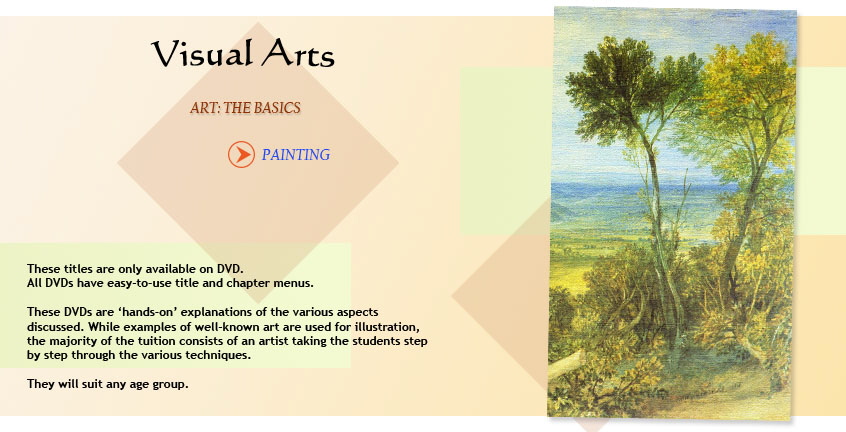|
ART: THE BASICS: PAINTING
Code D8: (DVD ONLY)
This DVD contains 3 programs
Program 1
Painting with Acrylics
Acrylic paints were first developed as a painting medium for mural artists to use on the exteriors of buildings, back in the 1920s. They needed a paint that was easy to use and quick to dry but also stable in changing conditions. Acrylic paints are made by bonding pigments in a resin that is made up of microscopic polymer chains, making it very tough and durable. They proved perfect for the job and were used extensively by the great Mexican mural painters, Siquieros (1896-1974) and Rivera (1886-1957).
During the 1950’s the technology of plastics improved and a new binding medium was introduced, PVC. By this stage more and more artists were using acrylic paints and artists like Jackson Pollock (1912-1956) found them very useful for painting in a quick, expressionistic way.
The characteristic of acrylic paint that makes it so attractive for artists is in its fast drying. This allows a thin layer of paint to be placed over a thicker one as soon as it has dried, the time water takes to evaporate. When the layers have dried they form a very strong bond, giving a very durable surface. Acrylic paint is a great medium for the artist as it frees up the working processes, and therefore should lead to greater creativity.
Program 2
Painting with Water Colours
Water colour paints are made by mixing finely ground pigments into ‘Gum Arabic’; a vegetable gum obtained from acacia trees. The gum is easily dissolved in water and gives a firm adherence when laid on to paper. In addition, it acts as a light, thin varnish, giving greater brilliance and luminosity to the colour.
Water colour paints first came to artists’ attention in the sixteenth century and one artist to use them extensively was the German artist Albrecht Dürer. By the eighteenth century they had become very popular, particularly in England, where paint technologists Winsor and Newton, were constantly making reliable paints for artists to use.
The chief characteristic of Water Colour is its transparency, a fact that should be exploited to the full. The lightest tones - highlights, bright skies, and whitish details – are given by the untouched paper, which is usually white. Unlike when you are painting with oil paint where you can lay lighter paint over darker tones, with water colour you must work through from the lightest tones to the darkest. Even a very light tone laid over a dark one will darken it further by covering more of the white paper underneath. It is this quality of the paper shinning through the transparent pigment which gives pictures in water colour the brilliance and sparkle which sets them apart from other styles of painting.
Program 3
Painting with Pastels
Pastels were first used by artists in the fifteenth century and at the time of Leonardo da Vinci were known as the dry colour method of painting. They’re made from chalk mixed with pigment and were first used mainly for doing preliminary studies or sketching. As time went by, artists started to use it as a medium for more finished works. It became a very popular during the late nineteenth century, when Impressionists, Monet, Manet, and Renoir used the medium widely.
Pastel is a medium that’s ideally suited to doing quick colour studies of a subject or with careful working can produce almost photographic results.
Like all art materials there are special rules that apply when working with pastels. To achieve a particular result certain steps have to be taken. Even the ‘tooth’, or roughness, of the paper that you will be working on, has an effect on the final picture. If you do follow a few simple rules that apply to all drawing, such as the need for careful observation, and starting with the broader shapes and then refining them, and a couple that apply more directly with working with pastels, like working from light to dark, great results can be achieved.
For prices, see our catalogue 
Back to top
|


